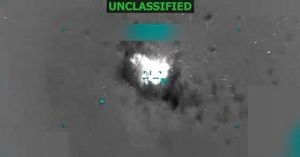For nearly eight years, the environmental balance of the Okapi Wildlife Reserve, designated as an endangered World Heritage Site, has been increasingly threatened by the expansive operations of Kimia Mining Investment, a Chinese mining company. Nestled within the lush forests of Congo's Ituri Province, this area is home to unique biodiversity, including the elusive okapi, often referred to as the forest giraffe.
Residents and wildlife conservators alike accuse the mining operation of wreaking havoc. The transformation of the pristine land has resulted in pollution seeping through the rivers and soil, alarming locals and experts who note the degradation of trees and the overwhelming surge of wildlife poaching due to the mine's presence. According to Joe Eisen, executive director of the Rainforest Foundation UK, "It is alarming...that a semi-industrial mining operation is being giving free rein...in what’s supposed to be a protected World Heritage Site."
The Okapi Wildlife Reserve spans over 13,000 square kilometers and serves as one of the world's richest biodiversity hotspots, making its protection imperative, especially as part of the larger carbon-rich Congo Basin rainforest. Yet, the recent resurgence of mining within the reserve raises serious concerns about environmental policies and regulation enforcement within the Democratic Republic of the Congo (DRC).
The mining activities, which include the recent operation renewal permits until 2048, are supposedly authorized under Congolese law. Kimia Mining maintains their operations are legitimate, relying on maps provided by the DRC's mining registry, indicating lawful grounds for their activities. Despite these assertions, multiple RED flags emerge, reflecting potential legal ambiguities—there’s been increasing scrutiny concerning the permits awarded, often claimed to be based on outdated or altered boundaries.
Research by environmentalists reveals the troubling shifts concerning protected area boundaries, with some alleging they have been illegally amended to facilitate mining interests. Initially established by the Congolese government three decades ago, these boundaries appear to have shrunk, giving way to Kimia Mining and the prospect of profits mined from the heart of the reserve.
While the mining registry claims to have consulted the Congolese Institute for the Conservation of Nature (ICCN) about updates, the ICCN insists it has never seen such communications. "The original boundaries should be used," ICCN representatives declared. This confusion over boundary change reflects deep-rooted issues of governance and the struggles of conservationists seeking to protect the reserve against the ravenous encroachment of mining interests.
Compounding these problems, attempts to reinstate the original protective boundaries are mired by uncertainty and government inertia. An internal memo revealed during discussions between ICCN and the mining registry indicated all companies operating within the reserve should cease their activities. Yet, it remains unclear when and how this will come to fruition.
Local communities, already grappling with the social and environmental impacts of the mining operations, voice their frustrations. Many say they had previously engaged in artisanal mining activities, only to be pushed out once the Chinese company arrived. The double standard irks many residents who note, "The community is worried...because the Chinese are mining...when it's forbidden for the community," as expressed by Jean Kamana, chief of the village Epulu. This sentiment captures the feeling of overall disenfranchisement experienced by these communities, many of whom now resort to illegal mining avenues.
Local residents describe their once-thriving environment transforming under the stress of large-scale industrial mining. Upsetting testimonies from locals reveal heartbreaking consequences: fishing yields have drastically plummeted, crops have become more challenging to cultivate, and access to productive resources has been severely restricted. "I can't send my children to private school anymore," lamented Muvunga Kakule, who by some accounts lost 95% of his income after Kimia Mining inhibited his ability to gain resources.
With waste and pollutants infiltrated land and waterways, residents like Assana, who once surveyed the abundant waters of the river for fish, are now forced to walk days for the same amount of catch they used to procure easily. Reports indicate more than 480 hectares (1,186 acres) of forest cover have been lost from January to May of this year alone. And yet, Kimia Mining counters these concerns by asserting their adherence to environmental standards. Kimia spokesperson Issa Aboubacar argued they employ thousands of locals, contributing to the area's economic framework.
Nevertheless, conservation experts and residents consistently paint a different picture, highlighting the use of toxic chemicals, like mercury, employed during gold extraction. Mercury, notorious for its detrimental impact on health, threatens both local populations and wildlife. A resident widespread chemical pollution rendered soil unfit for agriculture, compromising food security and local economics. Testimonies from residents are rife with stories of degraded living conditions, epitomizing their plight as they transition from self-sustaining practices to harmful dependency on heavily regulated mining operations.
While the DRC's government expresses intentions to rectify boundary issues and actively enforce conservation, the reality on the ground feels different. The rampant poaching, now accelerated due to the influx of people drawn to mining activities, is just another indicator of the fragile state of ecological integrity within the reserve.
Local leaders, like Wendo Olengama, espouse hope for positive change, calling for the Chinese mining company to invest back to the community by supporting sustainable endeavors such as responsible cattle farming or community training on ethical hunting. He voiced dire concerns over the prevailing conditions, “If the situation persists, we’ll live in misery. We won’t have food to eat.”
This duality of striving for conservation whilst ensuring local livelihoods remains the crux of the issue, where sound policies and enforcement will be increasingly necessary to walk the tightrope between development and survival. With promised communications and support from UNESCO, the DRC faces mounting pressure to clarify their commitments and prompt decisive actions. The health and preservation of the Okapi Wildlife Reserve hinge not only on the success of the conservation efforts but also on the increase of accountability within the DRC’s mining policies, ensuring sustainable practices safeguard both natural ecosystems and the communities they host.



